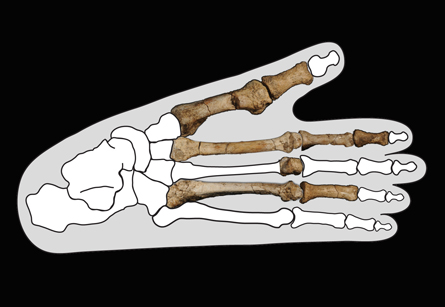Old relative steps down
Ancient human ancestor climbed trees but also walked clumsily upright on the ground
Share this:
- Share via email (Opens in new window) Email
- Click to share on Facebook (Opens in new window) Facebook
- Click to share on X (Opens in new window) X
- Click to share on Pinterest (Opens in new window) Pinterest
- Click to share on Reddit (Opens in new window) Reddit
- Share to Google Classroom (Opens in new window) Google Classroom
- Click to print (Opens in new window) Print

Stories about ancient times can be told by bones, and it doesn’t take many. Researchers needed only eight in the case of a new study on an old species. These bones, which had been buried in Ethiopia for 3.4 million years, were part of the toes of a newfound gorilla-like species.
Anthropologist Yohannes Haile-Selassie from the Cleveland Museum of Natural History worked on the new analyses of the bones. Anthropologists study humankind, and Haile-Selassie’s work explores the earliest human ancestors that walked upright. He told Science News that the newly discovered ancient species could climb trees and walk on two legs — although upright travel would have been difficult for this animal.
Millions of years ago, modern people were nowhere to be found. But there were animals that would eventually evolve, or change slowly over many generations, to give rise to humans as we think of them. These older species started as tree-swinging apes and over time developed into animals that walked upright on the ground. That’s why the new finding is exciting: This species may help scientists learn more about that transition.
Daniel Lieberman, an anthropologist at Harvard University, wrote an article about the new findings in the scientific journal Nature. Lieberman, who did not work on the new study, noted that the discovery
by Haile-Selassie’s team provides more evidence that even after ancient species started walking on the ground, their feet were built to climb trees.
The new foot bones also indicate that this species lived at the same time as another human ancestor known as Australopithecus afarensis. That species was identified in 1974 when scientists unearthed a partial skeleton, nicknamed “Lucy,” also in Ethiopia. Lucy is called a hominid, which means she walked upright on two legs and is related to ancient humans.
“For the first time, we have evidence of another hominid lineage that lived at the same time as Lucy,” anthropologist Bruce Latimer of Case Western Reserve University in Cleveland told Science News. Latimer worked with Haile-Selassie in analyzing the new bones. “This new find has a grasping big toe and no arch, suggesting [the species] couldn’t walk great distances,” he said. That would suggest it spent a lot of time in the trees.
Even though the newfound species lived at the same time as Lucy, its bones more closely resemble those of an older species called Ardipithecus ramidus. That species was identified a little over two years ago, based on a 4.4-million-year old partial skeleton, nicknamed Ardi. Both Ardi and the new species had short, big toes that curved and held tight to the second toe.
Eight bones from the foot may be enough to hint at a new species, but it’s not enough to get a new name. Anthropologist Tim White from the University of California, Berkeley, led the discovery and study of Ardi’s bones. He says that right now scientists have too little information to know how to fit the new species into the complex picture of human evolution.
“Haile-Selassie’s discovery highlights our lack of knowledge about hominid feet,” he told Science News.
Power Words (adapted from the New Oxford American Dictionary)
anthropology The study of humankind.
species A group of living organisms consisting of similar individuals.
arch The inner side of the foot.
evolution The process of change in species over long periods of time.
hominid A primate of an animal family that includes humans and their fossil ancestors.







